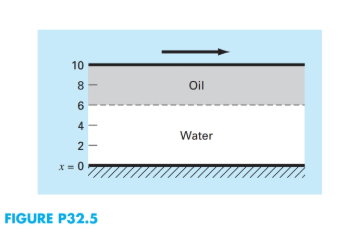
Two plates are 10cmapart, as shownin Fig.P32.5. Initially, both plates and the fluid are still. At
and the following relationships hold true at the oil-water interface:
What is the velocity of the two fluid layers at

Want to see the full answer?
Check out a sample textbook solution
Chapter 32 Solutions
EBK NUMERICAL METHODS FOR ENGINEERS
- Rather than the linear relationship of Eq. (1.7), you might choose to model the upward force on the parachutist as a second-order relationship. FU = −c'v2, where c' = a second-order drag coefficient (kg/m). a. Using calculus, obtain the closed-form solution for the casewhere the jumper is initially at rest (v = 0 at t = 0).b. Repeat the numerical calculation in Example 1.2 with thesame initial condition and parameter values. Use a value of0.225 kg/m for c' .arrow_forwardQ7 The x-component of the velocity vector is measured, at points A, B, and C 5 mm apart, as 11.3, 12.6, and 13.5 m/s, respectively, in the incompressible, steady plane flow shown in the figure. Estimate: a) The y-component of velocity 4 mm above point B. b) The acceleration at point B. Symmetrical flowarrow_forwardA sky diver weighing 192 lb (including equipment) falls vertically downward from a very high altitude. Assume that the air resistance is proportional to the falling velocity with the constant k = 0.6, the acceleration due to gravity g = 32ft/sec2, and that the positive direction is downward. What is the terminal velocity of the sky diver if he/she never opens the parachute?arrow_forward
- An object moves along a curve in the plane. What information do you gain about the motion of the object from the velocity vector to the curve at time t?arrow_forwardAn electron moves with a constant horizontal velocity of 3.0 x 100 m/s and no initial vertical velocity as it enters a deflector inside a TV tube. The electron strikes the screen after traveling 17.0 cm horizontally and 40.0 cm vertically upward with no horizontal acceleration. What is the constant vertical acceleration provided by the deflector? (The effects of gravity can be ignored.) 1.4 x 10 m/s? 14 2.5 x 10 m/s2 14 1.2 x 10 m/s? 8.3 x 10 m/s?arrow_forwardA basket of flowers of mass 3 kg is placed on a flat grassy slope that makes an angle θ with the horizontal. The coefficient of static friction between the basket and the slope is 0.45 and the basket is on the point of slipping down the slope. Model the basket of flowers as a particle and the grassy slope as a plane. Take the magnitude of the acceleration due to gravity, g, to be 9.8 m s−2 Express the forces in component form, in terms of θ and unknown magnitudes where appropriate. Write down the equilibrium condition for the basket and hence show that tan θ = 0.45. Determine the angle, in degrees, that the slope makes with the horizontal.arrow_forward
- Algebra & Trigonometry with Analytic GeometryAlgebraISBN:9781133382119Author:SwokowskiPublisher:Cengage
